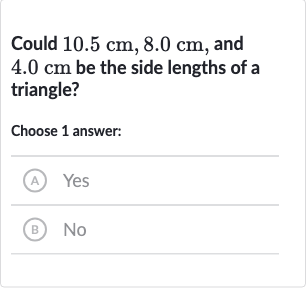Full solution
Q. Could , and be the side lengths of a triangle?Choose answer:(A) Yes(B) No
- Check Triangle Inequality Theorem: To determine if three lengths can form a triangle, we can use the Triangle Inequality Theorem, which states that the sum of the lengths of any two sides of a triangle must be greater than the length of the third side.
- Calculate Sum of Two Shortest Sides: First, we check if the sum of the two shortest sides is greater than the longest side. The two shortest sides are and , and the longest side is . We calculate and compare it to .
- Verify First Combination: The sum of the two shortest sides is , which is greater than the longest side, . This satisfies the Triangle Inequality Theorem for these two sides.
- Verify Second Combination: Next, we check the other two combinations to ensure they also satisfy the Triangle Inequality Theorem. We check if is greater than and if is greater than .
- Confirm Triangle Formation: The sum of and is , which is greater than . The sum of and is , which is greater than . Both of these sums satisfy the Triangle Inequality Theorem.
- Confirm Triangle Formation: The sum of and is , which is greater than . The sum of and is , which is greater than . Both of these sums satisfy the Triangle Inequality Theorem. Since all three combinations of side lengths satisfy the Triangle Inequality Theorem, the lengths , , and can indeed form a triangle.
More problems from Is (x, y) a solution to the system of equations?
QuestionGet tutor help

